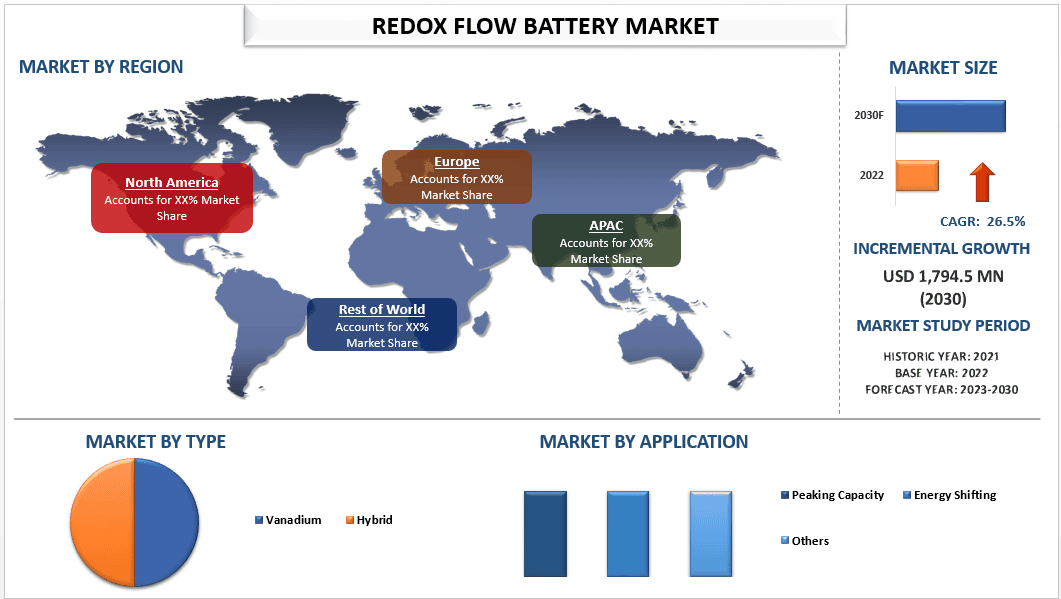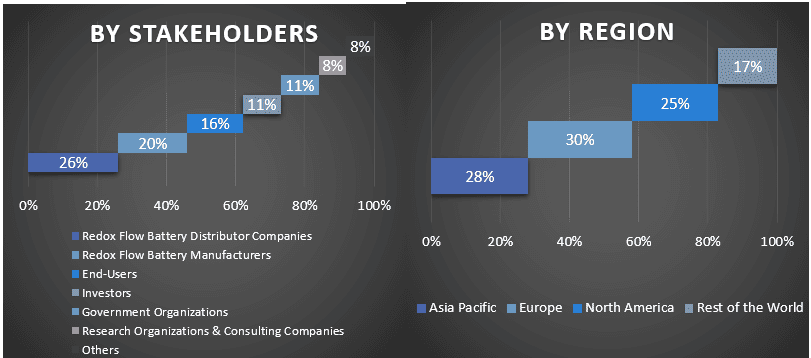レドックスフロー電池市場:現状分析と予測(2023年~2030年)
タイプ別(バナジウム、ハイブリッドなど)、用途別(ピーク対応、エネルギーシフト、その他)、地域/国

レドックスフロー電池市場 – 現在のシナリオと予測 (2023年~2030年)
レドックスフロー市場は、UPSの売上増加とバナジウム電池製品への投資増加により、予測期間中に26.5%の力強いCAGRで成長すると予想されています。レドックスフロー電池は、グリッドエネルギー貯蔵から負荷平準化まで、幅広い用途で大規模なエネルギー貯蔵に適しています。システム設計の柔軟性とコストスケーリングの能力により、レドックスフロー電池は、携帯型電子機器や電気自動車を含む様々な用途で有望視されています。
様々な企業が、北米、特にレドックスフロー電池の最大の市場の1つであるアメリカ合衆国に向けてサービスを拡大し始めています。例えば、住友電気工業株式会社は2023年2月、米国でレドックスフロー電池事業を拡大すると発表しました。US Vanadiumは、バナジウムレドックスフロー電池で使用される超高純度電解液の生産能力を200万ドルかけて拡張しました。ドイツの電池大手Gildemeister Energy Solutionsは、アメリカ経由で北米でCellCubeと呼ばれるバナジウムレドックスフロー電池を販売する予定です。様々なフロー電池の中で、バナジウムレドックスフロー電池は最も開発が進んでおり、高い体積エネルギー密度(約580 Wh L−1)を提供しています。しかし、電解液から代替電池化学物質を探索し、システム全体の性能とコストを改善する取り組みが行われています。膜なしレドックスフロー電池も開発されており、システムの柔軟性と費用対効果をさらに高めることができます。
市場で事業を展開している主なプレーヤーには、Enerox、住友電気工業、Bryte Batteries、H2, Inc.、Vionx Energy、Invinity Energy Systems¸ HydraRedox、Dalian Rongke Power Co., Ltd¸ Panzhihua Iron and Steel Group、Hebei Iron & Steel Groupなどがあります。これらのプレーヤーは、ハイテクで革新的な製品/技術を顧客に提供するために、いくつかのM&Aとパートナーシップを実施してきました。
レポートで提示された洞察
「タイプ別では、バナジウムセグメントが予測期間中に大幅なCAGRで成長するでしょう」
タイプに基づいて、レドックスフロー電池市場はバナジウムセグメントとハイブリッドセグメントに二分されます。バナジウムセグメントは、レドックスフロー電池市場で大部分のシェアを獲得し、予測期間中にかなりの成長率を記録すると予想されています。バナジウムレドックスフロー電池は、モジュール性、エネルギーと電力を独立して変更できる能力、および長いサイクルとカレンダー寿命により、そのスケーラビリティで知られています。これらは、マイクログリッド、ユーティリティスケールストレージ、再生可能エネルギー貯蔵などのアプリケーションに理想的な、中程度から長時間のエネルギー貯蔵に使用されます。バナジウムレドックスフロー電池は、適切なメンテナンスで無制限のサイクル寿命を持ち、展開の寿命を維持するための安定した容量を備え、不燃性で積極的な充放電耐性があります。
「アプリケーション別では、エネルギーシフトカテゴリが予測期間中に大幅なCAGRで成長するでしょう」
アプリケーションに基づいて、レドックスフロー電池市場は、ピーキングキャパシティ、エネルギーシフト、およびその他のセグメントに分割されます。エネルギーシフトセグメントは、レドックスフロー電池市場で大部分のシェアを獲得し、予測期間中にかなりの成長率を示すと予想されています。レドックスフロー電池は、長時間のエネルギーシフトに使用できるフロー電池の一種であり、グリッドスケールのエネルギー貯蔵に適しています。エネルギー省は、フロー電池、特にバナジウムレドックスフロー電池が、長時間のエネルギーシフトのニーズに合致することを示しています。バナジウムレドックスフロー電池は、地球の地殻にバナジウムが豊富に存在するため、フロー電池の特に魅力的なサブセットであり、使用に非常に適しています。
「APACは今後の期間中に高いCAGRで成長するでしょう」
APACはレドックスフロー電池市場で最高の市場シェアを登録し、予測期間中に影響力のあるCAGRを目撃すると予想されています。アジア太平洋地域のレドックスフロー電池市場は、中国、インド、日本、韓国などの国々からの需要増加により、大幅な成長を遂げています。さらに、インド、中国、日本などの経済圏に重要なOEM、電子部品メーカー、および電子デバイスアセンブラーが存在することにより、アジア太平洋地域のレドックスフロー電池市場がさらに推進されると予想されます。レドックスフロー電池は、再生可能エネルギーを貯蔵し、ソーラーパネルから供給される電力の信頼性を向上させる可能性から、人気が高まっています。ただし、市場はまだ初期段階にあるため、レドックスフロー電池市場は原材料の入手可能性に依存するなど、多くの課題に直面しています。原材料の不足や価格変動は、フロー電池のコストと生産に影響を与え、市場の成長に影響を与える可能性があります。
レドックスフロー電池市場レポートの範囲
レポート属性 | 詳細 |
基準年 | 2022年 |
予測期間 | 2023年~2030年 |
成長の勢い | CAGR 26.5%で加速 |
市場規模 2021年 | 2億7280万米ドル |
地域分析 | 北米、ヨーロッパ、APAC、その他の地域 |
主な貢献地域 | アジア太平洋地域は、予測期間中に最高のCAGRで成長すると予想されています |
対象となる主な国 | 米国、ドイツ、英国、イタリア、フランス、中国、日本、オーストラリア |
企業プロファイル | Enerox、住友電気工業、Bryte Batteries、H2, Inc.、Vionx Energy、Invinity Energy Systems¸ HydraRedox、Dalian Rongke Power Co., Ltd¸ Panzhihua Iron and Steel Group、Hebei Iron & Steel Group |
レポート範囲 | 市場動向、推進要因、抑制要因、収益の見積もりと予測、セグメンテーション分析、需要と供給側の分析、競争環境、企業プロファイル |
対象セグメント | タイプ別、アプリケーション別、地域/国別 |
このレポートを購入する理由:
- この調査には、認証済みの主要な業界専門家によって検証された市場規模と予測分析が含まれています。
このレポートは、全体的な業界のパフォーマンスを一目で簡単に確認できます。
- このレポートは、主要な財務、製品ポートフォリオ、拡張戦略、および最近の開発に重点を置いて、著名な業界の同業者の詳細な分析を網羅しています。
- 業界で普及している推進要因、抑制要因、主要なトレンド、および機会の詳細な調査。
- この調査は、さまざまなセグメントにわたって市場を包括的に網羅しています。
- 業界の地域レベル分析の詳細な調査。
カスタマイズオプション:
グローバルレドックスフロー電池市場は、要件またはその他の市場セグメントに応じてさらにカスタマイズできます。これに加えて、UMIは、お客様が独自のビジネスニーズを持っている可能性があることを理解しているため、お客様の要件に完全に適合するレポートを入手するために、お気軽にお問い合わせください。
目次
レドックスフロー電池市場分析(2023年~2030年)の調査方法
グローバルレドックスフロー電池市場の過去の市場を分析し、現在の市場を推定し、将来の市場を予測することは、グローバルな主要地域におけるレドックスフロー電池の採用を構築および分析するために行われた3つの主要なステップでした。過去の市場数値を収集し、現在の市場規模を推定するために、徹底的な二次調査が実施されました。次に、これらの洞察を検証するために、多数の調査結果と仮定が考慮されました。さらに、グローバルレドックスフロー電池市場のバリューチェーン全体にわたる業界の専門家との徹底的な一次インタビューも実施されました。一次インタビューを通じて市場数値を仮定および検証した後、トップダウン/ボトムアップアプローチを採用して、市場全体の規模を予測しました。その後、業界に属するセグメントおよびサブセグメントの市場規模を推定および分析するために、市場の内訳およびデータ三角測量法が採用されました。詳細な方法論を以下に説明します。
過去の市場規模の分析
ステップ1:二次ソースの詳細な調査:
年次報告書と財務諸表、業績プレゼンテーション、プレスリリースなどの企業内部ソース、およびジャーナル、ニュースと記事、政府刊行物、競合他社の刊行物、セクターレポート、サードパーティデータベース、およびその他の信頼できる刊行物などの外部ソースを通じて、レドックスフロー電池市場の過去の市場規模を取得するために、詳細な二次調査が実施されました。
ステップ2:市場セグメンテーション:
レドックスフロー電池市場の過去の市場規模を取得した後、主要地域のさまざまなセグメントおよびサブセグメントの過去の市場に関する洞察とシェアを収集するために、詳細な二次分析を実施しました。主要なセグメントは、タイプおよびアプリケーションとしてレポートに含まれています。さらに、地域におけるテストモデルの全体的な採用を評価するために、国レベルの分析が実施されました。
ステップ3:要因分析:
さまざまなセグメントおよびサブセグメントの過去の市場規模を取得した後、レドックスフロー電池市場の現在の市場規模を推定するために、詳細な要因分析を実施しました。さらに、レドックスフロー電池市場のタイプやアプリケーションなどの従属変数と独立変数を使用して要因分析を実施しました。世界中のレドックスフロー電池市場セクターにおけるトップパートナーシップ、M&A、事業拡大、および製品発売を考慮して、需要と供給側のシナリオの徹底的な分析が実施されました。
現在の市場規模の推定と予測
現在の市場規模の算定:上記の3つのステップからの実行可能な洞察に基づいて、グローバルレドックスフロー電池市場の現在の市場規模、主要なプレーヤー、およびセグメントの市場シェアに到達しました。必要なすべての割合シェア分割と市場の内訳は、上記の二次的なアプローチを使用して決定され、一次インタビューを通じて検証されました。
推定と予測:市場の推定と予測では、推進要因とトレンド、制約、および利害関係者が利用できる機会を含むさまざまな要因に重みが割り当てられました。これらの要因を分析した後、主要市場全体のさまざまなセグメントおよびサブセグメントの2030年の市場予測に到達するために、関連する予測手法、つまりトップダウン/ボトムアップアプローチが適用されました。市場規模を推定するために採用された調査方法は、次のとおりです。
- 収益(米ドル)と国内の主要市場全体でのレドックスフロー電池市場の採用率の観点から見た、業界の市場規模
- 市場セグメントおよびサブセグメントのすべての割合シェア、分割、および内訳
- 提供される製品の観点から見た、グローバルレドックスフロー電池市場の主要なプレーヤー。また、急速に成長する市場で競争するために、これらのプレーヤーが採用した成長戦略
市場規模とシェアの検証
一次調査:主要地域全体の上級幹部(CXO/VP、営業責任者、マーケティング責任者、運用責任者、地域責任者、カントリーヘッドなど)を含む主要なオピニオンリーダー(KOL)との詳細なインタビューを実施しました。次に、一次調査の結果を要約し、述べられた仮説を証明するために統計分析を実施しました。一次調査からのインプットは二次調査の結果と統合され、情報が実行可能な洞察に変わりました。
さまざまな地域における一次参加者の分割

市場エンジニアリング
データ三角測量技術を採用して、市場全体の推定を完了し、グローバルレドックスフロー電池市場の各セグメントおよびサブセグメントの正確な統計数値に到達しました。グローバルレドックスフロー電池市場におけるタイプおよびアプリケーションの分野におけるさまざまなパラメーターとトレンドを調査した後、データをいくつかのセグメントおよびサブセグメントに分割しました。
グローバルレドックスフロー電池市場調査の主な目的
グローバルレドックスフロー電池市場の現在および将来の市場動向は、調査で正確に指摘されました。投資家は、調査で実施された定性的および定量的な分析に基づいて投資に関する裁量を行うための戦略的洞察を得ることができます。現在および将来の市場動向は、地域レベルでの市場全体の魅力を決定し、業界の参加者が未開拓の市場を活用して、ファーストムーバーの利点から利益を得るためのプラットフォームを提供します。調査のその他の定量的な目標は次のとおりです。
- 金額(米ドル)の観点から、レドックスフロー電池市場の現在および予測市場規模を分析します。また、さまざまなセグメントおよびサブセグメントの現在および予測市場規模を分析します
- 調査のセグメントには、タイプおよびアプリケーションの分野が含まれます
- レドックスフロー電池産業の規制の枠組みを定義および分析します
- 業界の顧客と競合他社の行動を分析するとともに、さまざまな仲介業者の存在に関連するバリューチェーンを分析します
- 主要地域におけるレドックスフロー電池市場の現在および予測市場規模を分析します
- レポートで調査された地域の主要国には、アジア太平洋、ヨーロッパ、北米、および世界のその他の地域が含まれます
レドックスフロー電池市場の企業プロファイルと、急速に成長する市場で持続するために市場プレーヤーが採用した成長戦略
- 業界の詳細な地域レベル分析
よくある質問 よくある質問
Q1:世界のレドックスフロー電池市場の現在の市場規模と成長の可能性は何ですか?
Q2:世界のレドックスフロー電池市場の成長を牽引する要因は何ですか?
Q3:タイプ別では、どのセグメントが世界のレドックスフロー電池市場で最大のシェアを占めていますか?
Q4: グローバル Redox Flow Battery 市場における新たな技術とトレンドは何ですか?
Q5: 世界のレドックスフロー電池市場を支配するのはどの地域ですか?
Q6: グローバルなレドックスフロー電池市場で活動している主要企業は誰ですか?
関連 レポート
この商品を購入したお客様はこれも購入しました










